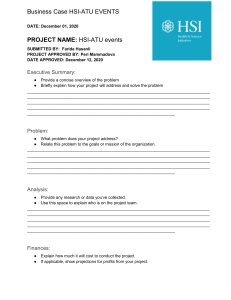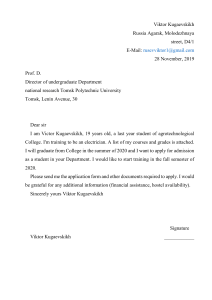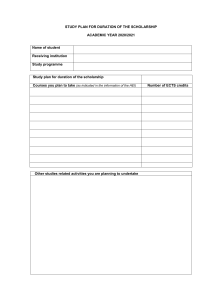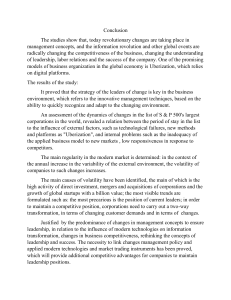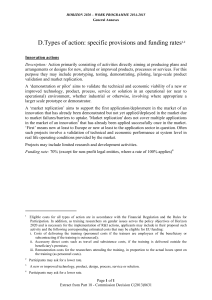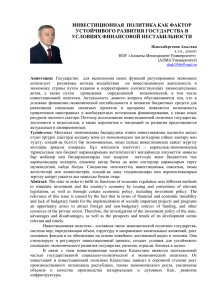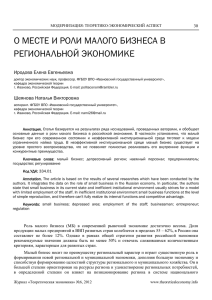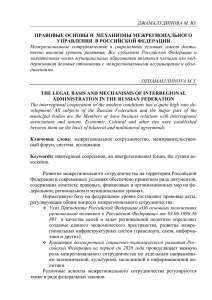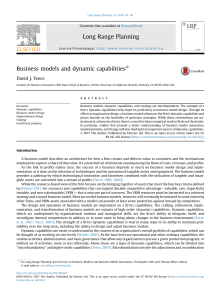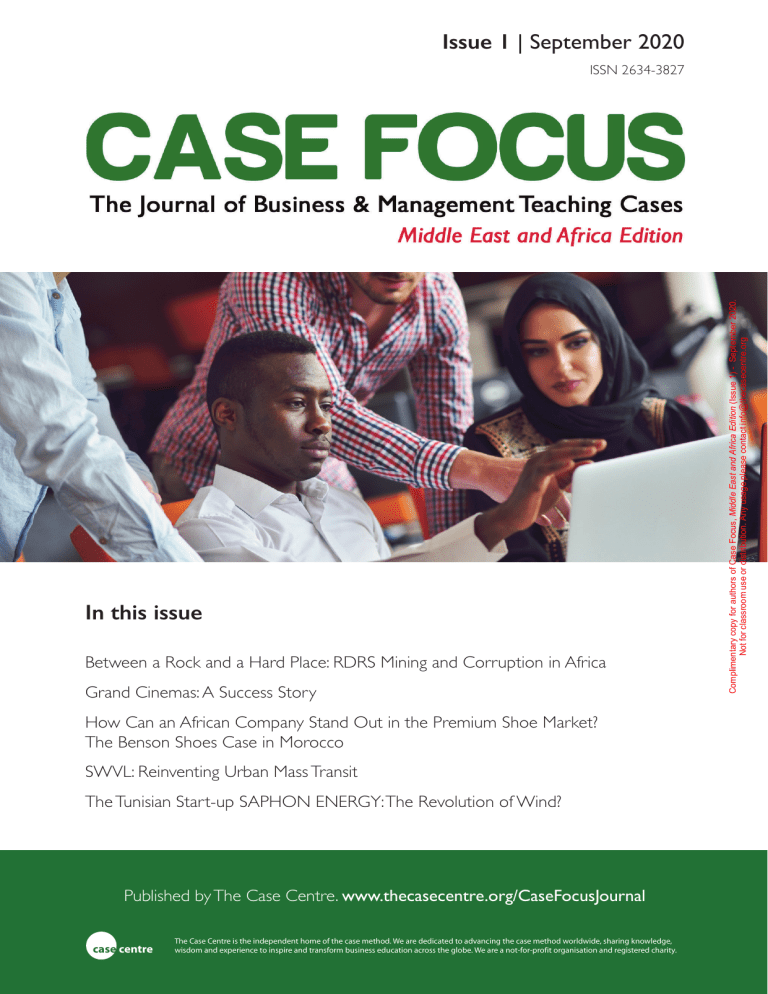
Issue 1 | September 2020 In this issue Between a Rock and a Hard Place: RDRS Mining and Corruption in Africa Grand Cinemas: A Success Story How Can an African Company Stand Out in the Premium Shoe Market? The Benson Shoes Case in Morocco SWVL: Reinventing Urban Mass Transit The Tunisian Start-up SAPHON ENERGY: The Revolution of Wind? Published by The Case Centre. www.thecasecentre.org/CaseFocusJournal case centre The Case Centre is the independent home of the case method. We are dedicated to advancing the case method worldwide, sharing knowledge, wisdom and experience to inspire and transform business education across the globe. We are a not-for-profit organisation and registered charity. Complimentary copy for authors of Case Focus, Middle East and Africa Edition (Issue 1) - September 2020. Not for classroom use or distribution. Any usage please contact info@thecasecentre.org ISSN 2634-3827 About Case Focus Buying the journal Case Focus offers a journal publication outlet for high-quality, peer reviewed teaching cases, with a focus on management and business situations in the Middle East and Africa (MEA) region. To buy an electronic copy of Case Focus, or copies of each individual case for teaching purposes, and to access the case teaching notes, visit: www.thecasecentre.org/CaseFocusJournal Production Antoinette Mills Media and Systems Development Manager antoinette@thecasecentre.org Hazel Walker External Relations Manager hazel@thecasecentre.org www.thecasecentre.org/CaseFocusIssues Submission information Information for authors about submitting to Case Focus can be found at: www.thecasecentre.org/CaseFocusRequirements Copyright © 2020 The Case Centre. All rights reserved. Editorial board Richard McCracken Editor-in-Chief The Case Centre John Mukum Mbaku Weber State University Alfons Sauquet Rovira ESADE Moses Acquaah Bryan School of Business and Economics, The University of North Carolina at Greensboro Bettina Bastian Holy Spirit University of Kaslik (USEK) Rachida Justo IE University Debapratim Purkayastha ICFAI Business School (IBS) Sherif H. Kamel School of Business,The American University in Cairo Haifa Jamalallail Effat University Hanane El Kouari IÉSEG School of Management Soumitra Dutta Cornell SC Johnson College of Business, Cornell University and Global Business School Network (GBSN) Howard Thomas Singapore Management University Thami Ghorfi ESCA School of Management Isseu Diop Sakho PATRIA SARL Tim Mescon AACSB International Case Focus Issue 1 | September 2020 1 Complimentary copy for authors of Case Focus, Middle East and Africa Edition (Issue 1) - September 2020. Not for classroom use or distribution. Any usage please contact info@thecasecentre.org The journal is published once a year by The Case Centre. ISSN 2634-3827 The significance of case writing on delivering impact across a school cannot be ignored. The case writing process initiates contact and generates research opportunities with local business, and aligns research and theory with learning in the classroom. Locally sourced cases offer students learning opportunities based on the lived reality of businesses in their region, and questions their aspirations in ways that are challenging but attainable. Welcome to this inaugural edition of Case Focus, our peer reviewed journal for teaching cases set across the Middle East and Africa. At a time when all of us in business and academia are being challenged to increase diversity in our leadership and structures, we cannot ignore barriers that restrict the representation of authors, protagonists and scenarios in the cases we teach. The Case Centre is committed to broadening the scope and diversity of cases within our collection. We welcome new voices from less represented regions who write cases about local businesses and cultural diversity, reflecting the concerns and career aspirations of their own students. Reflecting the strengths of our exceptional editorial board and reviewers, Case Focus will play its part in creating and encouraging a repertoire of cases from across the MEA region to add to the options available to you in your classroom. By supporting and encouraging the development of new case writers, this will have a positive impact on the research and teaching in schools throughout the region, especially in schools where the case method and teaching with cases is currently under-represented. Case Focus Issue 1 | September 2020 Case writing and the wider publication of cases supports schools as they build towards accreditation goals, brings awareness of their faculty and school into classrooms around the world, and creates opportunities for deeper engagement with the business communities in which they are imbedded. Furthermore, protagonists and their businesses benefit from stronger links with schools, and often use the relevant case in recruitment and induction, and to reflect on and improve their own lived experience. The challenge for us is to give a platform to the range of voices deserving to be heard. In this inaugural issue of Case Focus, we are pleased to bring you cases that represent a vibrant, diverse range of businesses across the MEA region, written by faculty who really get inside and inhabit the business cultures they explore: mining and corruption, entertainment, family business, urban mass transit, and energy start-up. Richard McCracken Editor-in-Chief, Case Focus Director, The Case Centre richard@thecasecentre.org 2 Complimentary copy for authors of Case Focus, Middle East and Africa Edition (Issue 1) - September 2020. Not for classroom use or distribution. Any usage please contact info@thecasecentre.org Hear from the Editor 4 Between a Rock and a Hard Place: RDRS Mining and Corruption in Africa Rick Stapenhurst McGill University, Canada Rasheed Draman African Centre for Parliamentary Affairs, Ghana 17 Grand Cinemas: A Success Story Hala Khayr Yaacoub and Sarah Abboud University of Balamand, Lebanon 27 How Can an African Company Stand Out in the Premium Shoe Market? The Benson Shoes Case in Morocco Imane El Ghazali and Zoulikha Maaroufi ESCA Ecole de Management, Morocco 40 SWVL: Reinventing Urban Mass Transit Ayman Ismail and Ahmed Dahawy The American University in Cairo, Egypt 59 The Tunisian Start-up SAPHON ENERGY: The Revolution of Wind? Thouraya Derouich Karoui Higher Institute of Technological Studies of Rades, Tunisia Case Focus Issue 1 | September 2020 Complimentary copy for authors of Case Focus, Middle East and Africa Edition (Issue 1) - September 2020. Not for classroom use or distribution. Any usage please contact info@thecasecentre.org In this issue 3 SWVL: Reinventing Urban Mass Transit Complimentary copy for authors of Case Focus, Middle East and Africa Edition (Issue 1) - September 2020. Not for classroom use or distribution. Any usage please contact info@thecasecentre.org Case Reference no 820-0041-1 Ayman Ismail and Ahmed Dahawy The American University in Cairo, Egypt This case is intended to be used as the basis for class discussion rather than to illustrate either effective or ineffective handling of a management situation. The case was compiled from published sources. © 2020, The American University in Cairo. No part of this publication may be copied, stored, transmitted, reproduced or distributed in any form or medium whatsoever without the permission of the copyright owner. Case Focus Issue 1 | September 2020 40 SWVL: Reinventing Urban Mass Transit A new challenge Complimentary copy for authors of Case Focus, Middle East and Africa Edition (Issue 1) - September 2020. Not for classroom use or distribution. Any usage please contact info@thecasecentre.org It was a chilly afternoon in November 2018 as Mostafa Kandil, co-founder and CEO of SWVL, stared at his computer monitor admiring the latest results of the company’s fund-raising campaign. Despite the disheartening weather, the ambiance in the office was as high as ever, reflecting the latest success of SWVL’s series B funding (exhibit 1). SWVL provided affordable transportation through an app-based private bus network and a sharing economy business model. Raising tens of millions of dollars, SWVL had not only raised the largest funding round in Egypt but also one of the biggest ever in the entire Middle East and North Africa (MENA) region. The start-up was rapidly becoming one of the greatest and fastest success stories in the region. The company’s unchallenged success, however, did not last as long as Kandil would have liked. Just as he was scrolling through the latest article regarding his company’s achievements, an alert lit up his screen: an urgent email from his Marketing Director with the subject line “Must Read!”. On that very same day, Uber had announced the launch of its Uber Bus service, adding a new entrant to a previously untapped market that SWVL had been pioneering. Confident of his entrepreneurial success, Kandil was not worried about the increasing competition, but he was aware that this entrant would have serious implications on his company and its current market, especially given rumors of a similar service set to be launched by Careem, another indirect competitor, in 2019. Uber and Careem were the two leading ride-hailing companies operating in Egypt and the region. Kandil was faced with a challenge that required much deliberation. How should SWVL react to these global players entering its market, and what were the implications for SWVL’s business model? What strategies should SWVL implement to retain its market share and existing customer base? Moreover, the recent merger between Uber and Careem added greatly to the intensity of these contenders. While these questions ran through Kandil's mind, he also saw the opportunity masquerading within the dilemma. He had already been formulating plans to expand SWVL internationally, intending to cross into both African and Asian countries that had similar inefficiencies in their transportation systems. This change in the market dynamics raised new questions regarding their international plans. Would SWVL be as successful entering new markets as it was in Egypt considering the different cultures associated with the diverse markets? How would they respond to Uber and Careem in their international strategy? Also, what growth and competitive strategies should SWVL focus on to take full advantage of this situation? The SWVL team The success of any start-up always begins with the strength of its entrepreneurs. Not only do the entrepreneurs have to possess a good set of skills that most experts in the field consider makes a “good entrepreneur”, but they also need to have good compatibility with the resources and opportunities in the market. This was one of the main reasons for the success of SWVL and its three co-founders, Mostafa Kandil, Mahmoud Nouh, and Ahmed Sabbah (exhibit 2). Kandil, the CEO, was a petroleum engineering graduate from the American University in Cairo (AUC). After pursuing such an intensive program, he decided that it was not his calling, and instead chose to explore different paths. That was how he found himself working for Careem, now one of SWVL’s top competitors. He excelled there, winning awards and performing very well, but, like all aspiring entrepreneurs, he did not wish to be a follower and wanted to create something new. Thus, after witnessing the difficulties facing the market while working with Careem, he decided to pursue the idea behind SWVL. Kandil banded together with two colleagues, Mahmoud Nouh and Ahmed Sabbah, to build the ultimate team that could bring his idea to fruition. Mahmoud became the COO, based on his background in operations management with several different maritime corporations. Ahmed handled the technology elements of the business, acting as CTO Case Focus Issue 1 | September 2020 41 SWVL: Reinventing Urban Mass Transit and put the knowledge and expertise he had gained working with several other successful start-ups into the infrastructure at SWVL. Having such a diverse team with knowledge of different areas of the industry allowed the young team to move faster than most other start-ups in the region. With its increasing team, SWVL had been able to grow rapidly since its launch. While the strong team showed great promise, the rapid growth of the company meant new challenges for Kandil and his co-founders, who needed to hire experts from around the world to sustain the globalization and attempt to cure the inefficiencies of the transportation system. Complimentary copy for authors of Case Focus, Middle East and Africa Edition (Issue 1) - September 2020. Not for classroom use or distribution. Any usage please contact info@thecasecentre.org By the end of January 2017, Kandil quit his job at Careem and started his new adventure at SWVL. On 1 February 2017, Kandil and his co-founders joined a start-up acceleration program at AUC Venture Lab (V-Lab), the university-based accelerator program at his alma-mater, the American University in Cairo. Through this program, Kandil and his team worked on refining their business model and testing their services, launching their app and first bus line in Cairo. The transport system in Egypt Egypt is one of the largest and most densely populated countries in the region. Cairo, the capital city, ranks 21st in terms of population density of all cities around the globe, and represented approximately 9,400 people per km2. With an average population growth rate of 2.3% over the previous 63 years, Egypt's initial urban infrastructure was not built to sustain such a rapidly growing population. As a result, public transportation in Egypt grew highly inefficient and unable to accommodate the population. Four main forms of public transport were used in Egypt's major cities: buses, microbuses, metro, and taxis (exhibit 3). The public transportation system was limited in capacity and quality. The buses and metro were often over-crowded and inconvenient, especially for the growing urban middle class, who were unable to afford private car ownership. This urban middle class, which represented approximately 40% of the society (as of 2015), faced a major challenge in securing an affordable, secure, reliable, and convenient mode of transportation. Currency devaluation and economic pressures had made it harder for the urban middle class to purchase their own private cars. Statistics showed that by December 2017, there were 9.9 million vehicles in Egypt, of which 5.1 million (51.5%) were licensed private cars. Although this figure seemed substantial, the number of private vehicles grew by 5.3% in 2017, around 9% in each of the previous two years (2015, 2016), and 12.2% in 2014. The number of buses also increased by approximately 9.1% from 2016 to 2017, showing a greater growth rate than that of private vehicles. While purchases of private cars continued to grow, the period between 2016-2018 witnessed a decline in private car purchases due to currency devaluation, inflation, and the reduction of gasoline subsidies. Private car ownership remained limited, and the need for an affordable, reliable, and clean means of transportation for the growing urban middle class continued to increase. Over the past five years, several technology-based private companies had entered the transportation market in Egypt, such as Uber and Careem. While they were able to deal with issues like safety and reliability, affordability remained a major challenge. These new entrants were primarily competing with the taxi system. Although Uber and Careem were priced close to traditional taxis, they remained unaffordable for most of the urban middle class for their daily commute. Filling the gap Kandil formulated the idea for SWVL after having a first-hand view of the inefficiencies affecting the regional transport market working for his former employer and current competitor, Careem. Kandil and his co-founders established that while ride-hailing applications such as Uber and Careem went a long way towards addressing the problems with inefficient transport in Egypt and similar Case Focus Issue 1 | September 2020 42 SWVL: Reinventing Urban Mass Transit Complimentary copy for authors of Case Focus, Middle East and Africa Edition (Issue 1) - September 2020. Not for classroom use or distribution. Any usage please contact info@thecasecentre.org emerging markets, there were still many segments of the market that were underserved. Competitors had solved the issue for a certain segment, tailoring a service that offered convenience and safety to a segment that could afford it. Its steep prices, however, proved its model to be less affordable for the day to day commute of the urban middle-class segment in Egypt and other emerging economies. SWVL saw this opportunity in the market, and decided to implement an innovative business model that offered both the convenience and safety offered by its competitors, while offering a reduced price which was possible by the concept of ride-sharing. While ride-sharing was not a new idea, SWVL was the first player to popularize and scale the concept in Egypt. This followed on from several less successful attempts with similar business models from other start-ups, who were not able to scale the model fast enough in such a demanding market. The way the model worked was simple yet highly effective. The company had the ingenious idea to utilize the high availability of buses in Egypt. Initial studies showed that the country had an abundant supply of underutilized private buses after a recent drop in tourist activities. Following intensive inspection and upgrading, SWVL decided to use them to offer shared rides along fixed routes to popular destinations, starting in Cairo and then branching out to other cities. SWVL worked on the concept that Egypt's densely populated cities had high volumes of passengers who wanted to commute similar routes; therefore, the service provided regular routes along with these calculated high-demand destinations. This model satisfied all the players involved: bus drivers who, until recently, had no form of fixed work and were not properly utilizing their vehicles, and urban middle-class commuters who, before the introduction of the application, did not have many viable options for commuting in the city. Thus, SWVL was able to offer users good-quality transport with the added features of safety and convenience, while also reducing the price through ride-sharing. SWVL’s highly tuned algorithm created an efficient system that scattered stops and routes in a manner that allowed users an average of six to eight minutes walking distance to a stop anywhere in the functional vicinity of the service. Using this unique value proposition of convenience, safety, and affordability, SWVL was able to enter and sustain a significant market share of a highly dominated market with huge brand names from an unexploited business angle. SWVL's current marketing strategy Due to its relatively new entrance to the market, SWVL engaged in very heavy promotion. It was still going through a push strategy implementation, where it heavily promoted the product to consumers. This was evident in its mass advertisements across the city (exhibit 4) and its adverts that flooded social media. Due to the existing large players in the market, SWVL needed a very strong promotional campaign to attract customers to its value proposition. This was why it also began using “promo codes”. Promotional codes acted as subsidies to their customers. When a customer entered a code, they were eligible for a certain discount depending on the marketing scheme. This had proved to be very effective with previous players in the market, and SWVL hoped to use this to its advantage. While this method was effective in activating potential customers, it was also very costly. SWVL, however, did not plan to pursue a push strategy for too long and aimed to adapt it into a pull strategy when it had acquired its desired market share. Subsidies were currently 40% of its cost scheme, but it planned to decrease these significantly after reaching certain statistics for customer retention. While promotion was one of the most important factors that SWVL needed to consider, it was also of the utmost importance that the team focused on the other factors of the marketing mix to secure the company's position in the market and grow its market share. Case Focus Issue 1 | September 2020 43 SWVL: Reinventing Urban Mass Transit Direct competitors Uber Complimentary copy for authors of Case Focus, Middle East and Africa Edition (Issue 1) - September 2020. Not for classroom use or distribution. Any usage please contact info@thecasecentre.org Uber, an American company, was amongst the first and largest companies to introduce ride-hailing applications globally. The company followed the revolutionary trend of the “sharing economy” that was sweeping the business world, where companies did not actually own their main assets. Uber was one of the largest transportation systems in the world, but it did not own any of its vehicles; they were, instead, private vehicles owned by individuals who were not directly employed by the company, but rather contractors who provided the services “on-demand”. SWVL operated with a similar model, not actually owning the buses that ran its service. Uber entered the Egyptian market in 2015, where it flourished but had significant issues. Uber worked by the use of an application, which acted as an interface between users who needed transportation and users who had vehicles ready for transport. The company also provided job opportunities for people who had vehicles and were looking for additional income. Uber revolutionized the transportation market in Egypt and experienced significant growth during its initial launch. Egypt was considered to be the most desirable market for Uber in the MENA region, leading to the company investing approximately $14 million in 2016 alone to continue to grow its market share. While the emerging market became highly attractive to the global brand, its expansion tactics did not come without challenges. While Egypt’s emerging market showed a wealth of users who required transport and users with vehicles looking for employment, Uber was unable to successfully implement its credit card-based model completely because of differences in credit card penetration and usage. Uber’s application worked using a credit card to facilitate payments. Most of the country's payments, however, were cash-based, with limited credit card penetration and usage according to MasterCard. This led to significant impacts on Uber’s growth plans in Egypt and opened the way for the entry of a new competitor to the market. Careem Careem, an Emirates-based start-up, was one of the first to follow Uber’s success in addressing inefficiencies in the transportation system in Egypt and the region. Careem employed a similar business model to Uber, where users who needed rides were matched with vehicle owners in the same vicinity. Careem played on Uber’s weaknesses in the market and set up its competitive edge there. Launching in Egypt in 2016, Careem was able to establish a name for itself in a previously dominated market. Due to its origin in a culture more similar to Egypt than its American counterpart, Careem saw a gap in the market, and provided its users with the option of cash payments. This had a very strong positive response and led to the company acquiring a large market share from Uber. This threat became so severe that it forced Uber to also implement a cash payment model in Egypt. Aside from cash options, Careem implemented several other culturally inspired features that gave it a competitive edge. While Uber promoted different levels of cars, having other products similar to UberX and Uber Select, which offered users a higher quality of car, Careem decided to go with another approach. It understood that the Egyptian market was in need of more affordable transportation which led to the launch of its new line of transport in 2017: Careem scooters. This line used the same model and application as the regular service, but it allowed users to choose the cheaper alternative of motorcycles as opposed to pricier vehicles. This also showed a distinction in the positioning of the two companies operating in the same market. While Uber was attempting to be more comfortable and exclusive, Careem was trying to be more affordable. Case Focus Issue 1 | September 2020 44 SWVL: Reinventing Urban Mass Transit Competitive pricing models Complimentary copy for authors of Case Focus, Middle East and Africa Edition (Issue 1) - September 2020. Not for classroom use or distribution. Any usage please contact info@thecasecentre.org One of the main factors these start-ups competed on was affordability. To what extent, however, did these start-ups actually compete in terms of pricing? A sample of the pricing ranges was averaged and compared for each of the three competitors, Uber, Careem, and SWVL, including a comparison to the closest substitutes available in the industry (exhibit 5). SWVL’s average in terms of overall price was the cheapest of the three services. The cheapest overall were public buses and informal means of transportation, such as microbuses, which were more common in most areas of the country, at an average rate of 10 EGP per trip, in comparison to SWVL, which offered an average rate of 30 EGP per trip. The monetary value saved, however, was expended through the loss of time, discomfort, and inconvenience. Another interesting observation found ride-hailing applications to actually be more expensive than metered public taxis, with rates of 100 EGP and 50 EGP per trip, respectively. Uber and Careem, however, cleverly marketed their services with promotional codes (as SWVL did) to offer riders discounts and incentives to ride with them, which made these fares more affordable in comparison with the fixed rates of public taxis. SWVL had positioned itself almost directly in the middle of its market, offering a moderate price, slightly higher than public transportation, and a selected range of the features provided by the considerably more expensive players in the market. Market challenges and legality of the business Although Uber and Careem had performed significantly well, they both faced large challenges in the Egyptian market. The biggest of these challenges attacked both companies directly when taxi drivers decided to revolt in 2016, staging multiple “sit-ins” on many of the busiest roads and bridges. These “sit-ins” involved taxis crowding onto busy highways and parking to block oncoming traffic, as indirect retaliation against the government for not responding to their demands. Taxi drivers were outraged that Uber and Careem’s operations had been allowed in Egypt, as they considered these companies to be operating illegally. While the companies were properly incorporated under Egyptian Companies Law, taxi drivers claimed they were illegal since their drivers did not hold legitimate taxi licenses. These ride-hailing applications were performing slightly too well and acquiring customers from taxi drivers, who, until recently, did not have much competition. These claims were based mostly on the threat of competition, but in fact, they turned out to be true. Cars operating in these platforms were not licensed for commercial use and were, therefore, operating illegally. In fact, in many European countries, Uber had been banned for similar reasons. Uber and Careem held discussions with the government regulators to discuss how they could introduce changes to the law to allow them to continue to operate. In June 2018, the government of Egypt issued a new law directly regulating the ride-sharing applications, but it also brought forth several new implications such as taxes and licensing fees, which previously had not affected the ride-hailing companies. While the government was in support of these ride-hailing applications offering many new jobs to the market, the “sit-ins” had serious negative implications for the entire city. They lasted for several weeks, although they could not be sustained as these public taxi drivers were losing too much business and were not getting anywhere with the government either. Therefore, many of the taxi drivers attempted other creative solutions such as using WhatsApp as a form of intermediary technology between them and consumers, and displaying their telephone numbers on their cars to establish higher convenience for their customers. Nevertheless, they could not fully implement the same features as their immediate competitors and there was still a lot of tension between them, although recent progress showed improvement. Careem, for example, added to its choice of cars an option to hail public taxis directly from its application, thereby bridging the gap in the market that had led to tension. Case Focus Issue 1 | September 2020 45 SWVL: Reinventing Urban Mass Transit Competitors’ response to SWVL Complimentary copy for authors of Case Focus, Middle East and Africa Edition (Issue 1) - September 2020. Not for classroom use or distribution. Any usage please contact info@thecasecentre.org The rapid success of SWVL caught the attention of the entire market. What once posed only an inconsequential threat to Uber and Careem now represented a substantial threat. SWVL had grown rapidly since its launch in Egypt, and now everybody wanted a piece of the pie. Both Uber and Careem understood that sticking to the expensive ride-hailing model and not adapting to the market's need for lower-cost solutions would lead to the loss of a significant opportunity, so they decided to react almost instantaneously. Immediately following SWVL’s multimillion-dollar series B funding, both businesses announced their very own bus lines as extensions to their ride-hailing model (exhibit 6). Uber Bus Uber wasted no time in its competitive response and was rumored to have been testing the market as early as September 2018. Uber Bus planned to launch its first pilot test on 4 December 2018, eager to get a head start on any other entrants attempting to tailgate SWVL. The bus service was almost a replica of a previous Uber line that was released in North America in 2015, known as Uber Hop. This was launched in Seattle and Toronto as a ride-sharing app that used buses moving along fixed routes to transport riders under a shared price scheme, much like SWVL's model in Egypt, yet with much fewer lines as it was only a pilot. While the idea had momentous potential, the pilot was canceled after seven months after being deemed to be unprofitable. Uber had also launched another ride-sharing scheme known as Uber Pool in 2014. This feature was basically the same as its ordinary model but with a car-pooling feature that allowed drivers to pick up multiple passengers on a single trip and have the fare shared between them. Therefore, the pilot of Uber Hop was cancelled as it was considered a form of self-cannibalisation since the predominant service seemed to be faring much more profitably in the market. Moreover, the public transportation systems in the regions in which it was released were not as inefficient as the emerging markets being targeted, therefore, the market was not as lucrative. In Egypt, however, or the Middle East for that matter, Uber never launched Uber Pool or an Arab counterpart, and might not have faced the same problem. Uber’s main value features offered to its consumers, aside from convenience, were security and comfort, which formed its higher price and positioning on its competitors’ grid. Thus, using a car-pooling feature might not have been as profitable as it was in the American market, due to its conflicts with the initial value proposition and product strategy. Uber Bus might have seemed more profitable since it was expected to be released on a price scheme that was approximately 30% cheaper than average taxi fares. Uber should still have been concerned, however, about whether this step conflicted with its initial proposition and customers' perception of it in comparison to competitors. While these challenges seemed dire, Uber showed significant determination regarding the project. Uber Bus was only set to launch in Egypt (out of the 60 countries in which it functioned) which appeared to be a direct response to SWVL’s disruption to the market. Also, the parent company planned to invest roughly $100 million over the next five years to support this endeavor. Careem Bus Fearing it would lose out on its chance to set up a base in this new prospective market, Careem also played its own expansionary tactic. It was due to release its own bus service, known as Careem Bus, as early as January 2019. Many statistics surfaced online and the news showed that this expansion might be more substantial than had earlier been perceived. Careem’s position in the market was rather interesting, as being an earlier investor in SWVL's seed funding round, Careem had invested $500,000 in SWVL. Early on, Careem had shown great interest in SWVL as evidenced by its investments, although since then, statistics at Reuters had shown that it exited its investment and became more focused on competing with SWVL, rather than growing with it. Case Focus Issue 1 | September 2020 46 SWVL: Reinventing Urban Mass Transit Careem Bus was planning to position itself much closer to SWVL by offering riders fares 60-70% cheaper than those of its car service. Furthermore, Careem had taken steps to attempt to improve efficiency by acquiring Commute, an Indian mass transport app. The application was set to be developed and attuned to better service the Egyptian market, with new technologies not yet revealed. Careem Bus planned on a “mid-pricing” strategy to directly target the middle class, forecasting an impending overlap on the competitive grid of the market, of which SWVL needed to be wary. Complimentary copy for authors of Case Focus, Middle East and Africa Edition (Issue 1) - September 2020. Not for classroom use or distribution. Any usage please contact info@thecasecentre.org Both Uber and Careem showed extreme eagerness to join the bus-sharing market and were investing a sizable amount of resources towards that goal. Many indications showed them to be pursuing SWVL's bus-sharing model, with their own minor variations. Nevertheless, there were many aspects that prevented the mega-companies from entering the market and profiting as easily, such as control and reliance on the supply of buses. Also, both competitors had released pilot lines within the previous few months, giving SWVL some time to respond, while still posing an imminent threat. Expansion ideas As a responsive entrepreneur, Kandil and his team had formulated many prospective plans to expand and grow the business. Following major growth in their first year of operation, the founders began to formulate ideas for regional and international expansion. By the end of 2018, the company had only functioned in Egypt in two main regions, Cairo and Alexandria. It hoped to expand to more routes in Egypt but also to go international with the brand, as many other emerging economies suffered from similar inefficient transportation systems. With this in mind, SWVL hired a new Vice President for Expansion, and invested a large portion of the Series B funding to open a research and development center in Berlin to focus on developing new product features and operational improvements and to attract global talent. After intensive research and deliberation, the team set their sights on three main regions: Africa, the Middle East, and Southeast Asia. SWVL had already launched in Kenya in early 2019; however, it was still very early in its operational processes, and it was looking to advance into other similar regions. Africa: Nairobi, Kenya Uber launched in Nairobi in the same year as in Egypt, 2015, and the market experienced a significant boom as a result. While the Egyptian market was far more consolidated, with only three major players, the Nairobi market was heavily fragmented. Uber paved the way for several local ride-hailing applications such as Taxify, Little Cab, Mondo Ride, and MaraMoja, each of which implemented its own price schemes (exhibit 7). Nairobi's formal bus system was thought to have collapsed in the 1990s, and since then no formal ride-sharing applications had been announced, but there had been several applications trying to optimize transit and transportation in the city, such as Magic Bus and Transit App. While these companies helped users find the nearest routes and bus systems, they were not actually responsible for building or regulating the bus system itself as SWVL was. At the beginning of 2019, SWVL launched its first international venture in Nairobi, Kenya. This African city was one of the top sites for SWVL’s expansion due to its similarities in demographics. While the countries had very different statistics, both Nairobi and Cairo showed exponential population growth and poor elements of urban infrastructure. Although the population in Nairobi was much smaller than Cairo, its average growth was expected to be a staggering 4%, almost double that of Cairo. Also, Nairobi had a relatively high population density of approximately 3,948 per km2. Due to its status as an emerging market, many industries, along with transportation, were investing in the country to take advantage of the rising markets. While the economy was growing in Case Focus Issue 1 | September 2020 47 SWVL: Reinventing Urban Mass Transit Nairobi, there was still substantial income disparities, with 22% of the city below the poverty line. The city’s public transportation was lagging behind, mainly relying on taxis and microbuses. Nairobi also had a train system for daily commuters that went across the city. Asia: Manila, Philippines Complimentary copy for authors of Case Focus, Middle East and Africa Edition (Issue 1) - September 2020. Not for classroom use or distribution. Any usage please contact info@thecasecentre.org The mega-city Manilla showed a closer resemblance to Cairo’s overflowing population, with the Philippine capital hosting a massive 13.5 million people. Although the country was very populous, the city itself had the highest population density in the world at 42,857 people per km2. In comparison, Cairo had only around 9,000 people per km2. However, the city growth was limited at only approximately 0.44% on an annual basis. In Manila, transportation was more advanced than Cairo but just as unregulated and lacking in maintenance. Along with small companies running bus/micro-bus systems across the city, its main transport system was an integrated railway system composed of two main segments: the Manila Light Rail Transit System (LTRA) and the Manila Metro Rail Transit System (MRTC). These provided an alternative service to the market, although they raised their own issues. After they changed ownership in 2012, the safety and security of these railroads became highly questionable. Also, they were not entirely reliable in terms of times of arrival and departure. While the industry was slightly different from Cairo's, the market was quite similar. Private transportation platforms were mainly dominated by two competitors: Uber, and Grab (a Singaporebased competitor). In April 2018, the market was severely disrupted by a planned merger between Uber and Grab, and the dissolution of Uber in Manila. Collectively, both companies controlled roughly 80% of the market. The merger was still in process, as it was under strict scrutiny by the government and antitrust regulators. A similar issue was being invoked in Egypt’s market, with the recently announced merger between Uber and Careem, which would have severe implications for the market (exhibit 8). The challenge On 23 November 2018, Kandil was admiring the success of his rapidly growing start-up. SWVL was almost seamlessly expanding in a market that had been previously dominated by Uber and Careem. While this growth seemed to be undisturbed, both competitors wanted to join SWVL’s success. Kandil was not surprised to hear of each company's prospective launch of a new service line directly created to respond to SWVL’s disruption to the market. While this was not too distressing for Kandil and his team, it still posed an issue to ponder. How should SWVL react to these global players entering its market? What competitive strategies should it implement to retain its market share and customer base, and continue to grow locally and internationally? Case Focus Issue 1 | September 2020 48 SWVL: Reinventing Urban Mass Transit Exhibits Complimentary copy for authors of Case Focus, Middle East and Africa Edition (Issue 1) - September 2020. Not for classroom use or distribution. Any usage please contact info@thecasecentre.org Exhibit 1. SWVL investment rounds Source: www.crunchbase.com * Includes investments in both series B-1 and B-2. Case Focus Issue 1 | September 2020 49 SWVL: Reinventing Urban Mass Transit Exhibit 2. SWVL founders Complimentary copy for authors of Case Focus, Middle East and Africa Edition (Issue 1) - September 2020. Not for classroom use or distribution. Any usage please contact info@thecasecentre.org SWVL co-founders: Mostafa Kandil, Mahmoud Nouh, and Ahmed Sabbah. Source: https://egyptianstreets.com/2018/04/23/swvl-raises-8m-largest-series-a-round-for-an-egyptian-tech-startup Case Focus Issue 1 | September 2020 50 SWVL: Reinventing Urban Mass Transit Complimentary copy for authors of Case Focus, Middle East and Africa Edition (Issue 1) - September 2020. Not for classroom use or distribution. Any usage please contact info@thecasecentre.org Exhibit 3. Vehicle statistics in Egypt Source: Egypt's Central Agency for Public Mobilization and Statistics (CAPMAS) Note: These figures show the change in statistics for licensed vehicles and the specified breakdown for 2014-2017. It should be noted that growth rates for between 2014 and 2016 represent two years of growth, while growth rates for 2016-2017 only represent one year. 2018 data is not available yet. Case Focus Issue 1 | September 2020 51 Complimentary copy for authors of Case Focus, Middle East and Africa Edition (Issue 1) - September 2020. Not for classroom use or distribution. Any usage please contact info@thecasecentre.org SWVL: Reinventing Urban Mass Transit Exhibit 4. Examples of SWVL campaigns Photo credit: www.insiteooh.com Case Focus Issue 1 | September 2020 52 Photo credit: SWVL Exhibit 5. Affordability and price comparison Case Focus Issue 1 | September 2020 Complimentary copy for authors of Case Focus, Middle East and Africa Edition (Issue 1) - September 2020. Not for classroom use or distribution. Any usage please contact info@thecasecentre.org SWVL: Reinventing Urban Mass Transit 53 SWVL: Reinventing Urban Mass Transit Exhibit 6. Uber and Careem response Complimentary copy for authors of Case Focus, Middle East and Africa Edition (Issue 1) - September 2020. Not for classroom use or distribution. Any usage please contact info@thecasecentre.org Egyptian Streets: Careem and Uber Launch Bus-Booking Service to Rival SWVL 4 December 2018 By: Nour Eltigani Photo credit: Careem Uber’s Middle Eastern ride-sharing app rival Careem, announced on 3 December that it introduced a new bus-booking service in Egypt. “‘Careem Bus’ represents the middle ground between the existing public transport and ride-hailing cars. We believe that a middle-priced service that middle-income residents and commuters can use every day will make a big difference,” Careem said in a statement. The app allows the users to select their pick-up and drop-off location; it will display meeting-point options that are closest to those locations as well as the time. The rate fares 60 to 70% cheaper than those of the car service. Last year, Careem invested USD 500,000 in the Egyptian bus-booking start-up app, SWVL, which is marketed as a “premium alternative to public transportation”. According to Reuters, however, Careem revealed that “it has since divested the stake”. SWVL already announced last month that it will be launching in Southeast Asia after receiving a lump sum worth millions of dollars in the latest funding round. Careem’s major competition in the Middle East is San Francisco-headquartered Uber Technologies, who also announced on 1 October that they too will be launching a bus-booking service in Egypt’s capital, Cairo. Case Focus Issue 1 | September 2020 54 Complimentary copy for authors of Case Focus, Middle East and Africa Edition (Issue 1) - September 2020. Not for classroom use or distribution. Any usage please contact info@thecasecentre.org SWVL: Reinventing Urban Mass Transit Photo credit: Publicist Inc. Cairo will be the first city in the world where Uber introduces this service. Uber users will be able to see ‘Uber Bus’ as an option in the app as opposed to downloading a new app dedicated to its bus-booking service like ‘Careem Bus’. Reuters revealed last month that Careem has been working with Jefferies, the American multinational investment bank, to determine investment options, fundraising, and a “potential merger and acquisition deal in the region with Uber”. Source: https://egyptianstreets.com/2018/12/04/careem-and-uber-launch-bus-booking-service-to-rival-swvl Case Focus Issue 1 | September 2020 55 SWVL: Reinventing Urban Mass Transit Complimentary copy for authors of Case Focus, Middle East and Africa Edition (Issue 1) - September 2020. Not for classroom use or distribution. Any usage please contact info@thecasecentre.org Exhibit 7. Price comparison for ride hailing services in Nairobi, Kenya https://techweez.com/2017/03/16/uber-vs-taxify-little-cab-mondo-ride-maramoja Fares are represented in KES (national currency of Kenya) $1=102.71 KES (conversion rate as of 23 November 2018). Exhibit 8. Uber acquires Careem SAN FRANCISCO AND DUBAI Uber, and Careem have reached an agreement for Uber to acquire Careem for $3.1 billion, consisting of $1.7 billion in convertible notes and $1.4 billion in cash. The acquisition of Careem is subject to applicable regulatory approvals. The transaction is expected to close in Q1 2020. Uber will acquire all of Careem’s mobility, delivery, and payments businesses across the greater Middle East region, ranging from Morocco to Pakistan, with major markets including Egypt, Jordan, Pakistan, Saudi Arabia, and the United Arab Emirates. Upon closing, Careem will become a wholly-owned subsidiary of Uber, preserving its brand. Careem co-founder and CEO Mudassir Sheikha will lead the Careem business, which will report to its own board made up of three representatives from Uber and two representatives from Careem. Careem and Uber will operate their respective regional services and independent brands. “This is an important moment for Uber as we continue to expand the strength of our platform around the world. With a proven ability to develop innovative local solutions, Careem has played a key role in shaping the future of urban mobility across the Middle East, becoming one of the most successful start-ups in the region. Working closely with Careem’s founders, I’m confident we will deliver exceptional outcomes for riders, drivers, and cities, in this fast-moving part of the world,” said Uber CEO, Dara Khosrowshahi. “Joining forces with Uber will help us accelerate Careem’s purpose of simplifying and improving the lives of people, and building an awesome organization that inspires. The mobility and broader internet opportunity in the region are massive and untapped and have the potential to leapfrog our region into the digital future. We could not have found a better partner than Uber under Dara’s leadership to realize this opportunity. This is a milestone moment for us and the region, and will serve as a catalyst for the region’s technology ecosystem by increasing the availability of resources for budding entrepreneurs from local and global investors,” said Careem CEO and co-founder, Mudassir Sheikha. The greater Middle East region is already seeing the economic and social benefits of rapid technology adoption and improved access to transportation. This transaction supports the collective ability of Careem and Uber to improve the region’s transportation infrastructure at scale and offer diverse mobility, delivery and payment options. It will speed up the delivery of digital Case Focus Issue 1 | September 2020 56 SWVL: Reinventing Urban Mass Transit services to people in the region through the development of a consumer-facing super-app that offers services such as Careem’s digital payment platform (Careem Pay) and last-mile delivery (Careem NOW). Complimentary copy for authors of Case Focus, Middle East and Africa Edition (Issue 1) - September 2020. Not for classroom use or distribution. Any usage please contact info@thecasecentre.org This transaction brings together Uber’s global leadership and technical expertise with Careem’s regional technology infrastructure and proven ability to develop innovative local solutions. Both companies believe it will provide an opportunity to expand the variety and reliability of services offered, at a broader range of price points to serve more consumers. Similarly, for drivers and captains, the companies believe an increase in trip growth and improved services could provide better work opportunities as well as higher and more predictable earnings through greater utilization of drivers’ time on the road. Jefferies LLC acted as exclusive financial advisor to Careem on the transaction. About Uber Uber’s mission is to create opportunity through movement. We started in 2010 to solve a simple problem: how do you get access to a ride at the touch of a button? More than 10 billion trips later, we’re building products to get people closer to where they want to be. By changing how people, food, and things move through cities, Uber is a platform that opens up the world to new possibilities. About Careem Careem is the internet platform for the greater Middle East region. A pioneer of the region’s ride-hailing economy, Careem is expanding services across its platform to include mass transportation, delivery, and payments. Careem’s mission is to simplify and improve the lives of people and build a lasting organization that inspires. Established in July 2012, Careem operates in 120 cities across 15 countries and has created more than one million economic opportunities in the region. Source: https://www.uber.com/newsroom/uber-careem Case Focus Issue 1 | September 2020 57 SWVL: Reinventing Urban Mass Transit References BBC News. (2019) What's behind Uber's success in Egypt? [online]. Available from: https://www.bbc.com/news/business-39416041 [Accessed 8/28/19]. Citymayors.com. (2019) City Mayors: Largest cities in the world by population density (1 to 125). [online]. Available from: http://www.citymayors.com/statistics/largest-cities-density-125.html [Accessed 8/28/19]. Complimentary copy for authors of Case Focus, Middle East and Africa Edition (Issue 1) - September 2020. Not for classroom use or distribution. Any usage please contact info@thecasecentre.org Digital Boom. (2019) Careem launches minibus service in Egypt - Digital Boom. [online]. Available from: https://adigitalboom.com/careem-launches-minibus-service-in-egypt [Accessed 8/28/19]. Eltigani, N. (2019) Careem and Uber Launch Bus-Booking Service to Rival Swvl | Egyptian Streets. [online] Egyptian Streets. Available from: https://egyptianstreets.com/2018/12/04/careemand-uber-launch-bus-booking-service-to-rival-swvl [Accessed 8/28/19]. English.ahram.org.eg. (2019) Egyptian taxi drivers start open-ended sit-in to demand Uber, Careem shutdown - Politics - Egypt - Ahram Online. [online]. Available from: http://english.ahram.org.eg/NewsContent/1/64/190482/Egypt/Politics-/Egyptian-taxi-drivers-startopenended-sitin-to-dem.aspx [Accessed 8/28/19]. Egypt Independent. (2019) Uber to launch new bus services in Egypt: Ministry of Investment Egypt Independent. [online]. Available from: https://ww.egyptindependent.com/uber-to-launch-newbus-services-in-egypt-ministry-of-investment [Accessed 8/28/19]. Egyptian Streets. (2019) Swvl Raises $8M, Largest Series A Round for an Egyptian Tech Startup. [online]. Available from: https://egyptianstreets.com/2018/04/23/swvl-raises-8m-largest-series-around-for-an-egyptian-tech-startup [Accessed 8/28/19]. EgyptToday. (2019) Uber follows Careem, launches Uber Bus in Egypt. [online]. Available from: http://www.egypttoday.com/Article/3/61418/Uber-follows-Careem-launches-Uber-Bus-in-Egypt [Accessed 8/28/19]. Farquharson, M. (2019) Speaking About Uber’s Financial Investment in Egypt. [online]. BORGEN. Available from: https://www.borgenmagazine.com/ubers-investment-in-egypt [Accessed 8/28/19]. Hern, A. (2019) Uber launches feature which is basically a very small bus. [online]. The Guardian. Available from: https://www.theguardian.com/technology/2015/dec/09/uber-uberhop-bus [Accessed 8/28/19]. Nikkei Asian Review. (2019). Uber-Grab deal hits Manila's commuters and drivers. [online] Available from: https://asia.nikkei.com/Economy/Uber-Grab-deal-hits-Manila-s-commuters-anddrivers [Accessed 28 August 2019]. Worldpopulationreview.com. (2019) Manila Population 2020. [online]. Available from: http://worldpopulationreview.com/world-cities/manila-population [Accessed 8/28/19]. Worldpopulationreview.com. (2019) Nairobi Population 2020. [online]. Available from: http://worldpopulationreview.com/world-cities/nairobi-population [Accessed 8/28/19]. Worldometers.info. (2019) Egypt Population (2019) - Worldometers. [online]. Available from: http://www.worldometers.info/world-population/egypt-population [Accessed 8/28/19]. Case Focus Issue 1 | September 2020 58 case centre We: • distribute the world’s largest collection of management cases, articles and books on behalf of all the major business schools and internationally respected authors worldwide • provide training in case method teaching, learning and writing led by globally renowned experts • run international case awards and competitions; offer case writing scholarships; and publish books and articles by eminent case method specialists • offer authors an efficient and effective worldwide case publishing and distribution service. Become a member We are a registered charity and currently have over 500 member organisations from all over the world. Our members are a vital part of The Case Centre community and at the heart of everything we do. Find out more about becoming a member: www.thecasecentre.org/join Stay in touch with us www.linkedin.com/company/the-case-centre @TheCaseCentre www.facebook.com/thecasecentre www.thecasecentre.org info@thecasecentre.org Complimentary copy for authors of Case Focus, Middle East and Africa Edition (Issue 1) - September 2020. Not for classroom use or distribution. Any usage please contact info@thecasecentre.org The Case Centre is the independent home of the case method. We are dedicated to advancing the case method worldwide, sharing knowledge, wisdom and experience to inspire and transform business education across the globe. We are a registered charity and not-for-profit organisation.
